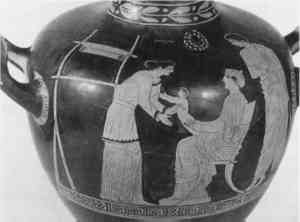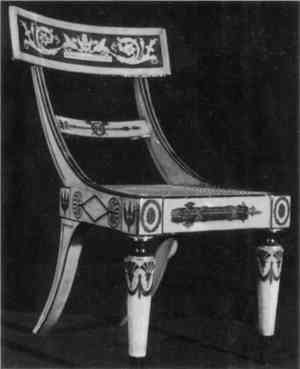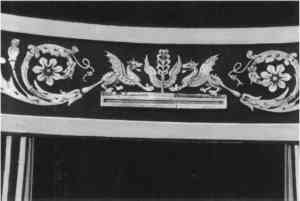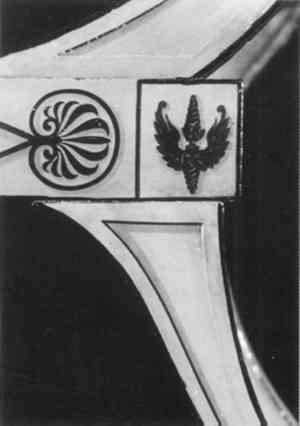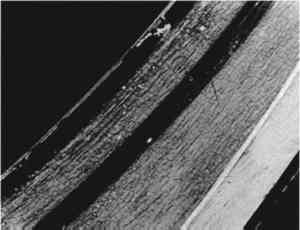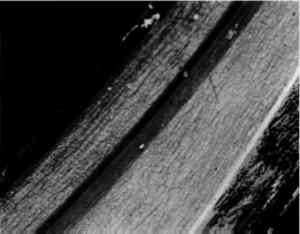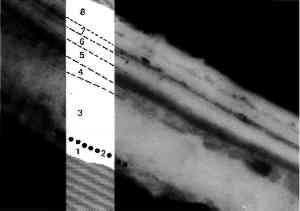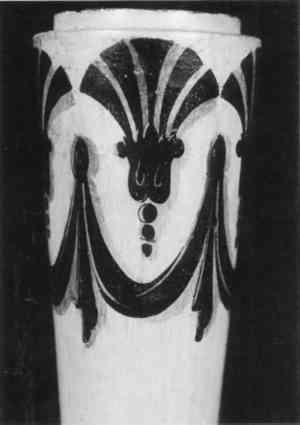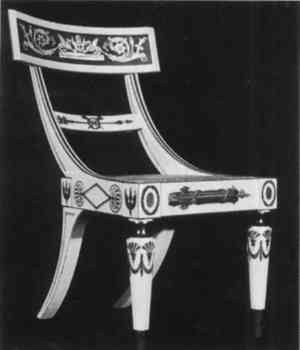THE CONSERVATION OF A PAINTED BALTIMORE SIDECHAIR (ca. 1815) ATTRIBUTED TO JOHN AND HUGH FINLAYPETER L. FODERA, KENNETH N. NEEDLEMAN, & JOHN L. VITAGLIANO
ABSTRACT—A yellow painted sidechair, attributed to John and Hugh Finlay and in the Collection of the Kaufman Americana Foundation, was conserved in a collaborative effort among conservators, conservation scientists, historians, and the owners. It is one of 11 known examples from a set representing the epitome of neoclassical chairs in the Baltimore style. Eight other examples from the set are in important museum collections, and they have been exhibited and widely illustrated, all in the context of one treatment executed in 1967, which left the chairs heavily overpainted and varnished. The treatment carried out by the authors on the Kaufman Foundation's chair focused on the conservation of the decorative surface. We believe the results will contribute to a reevaluation of the overall aesthetic sophistication of this important object. TITRE—La Conservation d'une Chaise Baltimore Peinte (ca. 1815) Attribu�e a John et Hugh Finlay. R�SUM�—Une chaise peinte en jaune, attribu�e � John et Hugh Finlay et appartenant � la Fondation Kaufman Americana a �t� restaur�e gr�ce � un effort conjoint des restaurateurs, des scientifiques, des historiens et des propri�taires de la chaise. Cet objet fait partie d'un ensemble de onze chaises qui represente l'�pitom� du n�oclassique dans le style Baltimore. Huit autres chaises de l'ensemble appartiennent � d'importants mus�es et ont �t� expos�es et amplement document�es lors de leur restauration en 1967, restauration qui laissa les chaises recouvertes d'une �paisse couche de peinture et de vernis. Le traitement de la chaise appartenant � la Fondation Kaufman a port� sur la conservation de la surface d�corative et les auteurs esp�rent que ce travail contribuera � la r��valuation de la sophistication esth�tique globale de cet important objet. T�TULO—La conservaci�n de una silla estilo Baltimore pintada de amarillo (circa 1815) atribuida a John y Hugh Finlay. RESUMEN—Mediante un trabajo de colaboraci�n entre conservadores, cient�ficos de la conservaci�n, historiadores y los due�os, se realiz� la conservaci�n de una silla sin brazos y pintada de amarillo, de la colecci�n de la Fundaci�n Kaufman Americana. Esta pieza atribuida a John y Hugh Finlay, es un ejemplo de un juego de 11 que representa el paradigma de sillas neocl�sicas de estilo Baltimore. Otro ocho ejemplos del juego pertenecen a importantes colecciones de museos. Estas fueron exhibidas y ampliamente ilustradas en el contexto de un tratamiento realizado en 1967, que dejo a las sillas excesivamente repintadas y barnizadas. El tratamiento de la silla llevado a cabo por los autores se centr� en la conservaci�n de la superficie decorada. Se espera que este trabajo a revalorizar la sofisticaci�n est�tica de este objeto tan importante. 1 BACKGROUNDMaryland generated a great quantity of furniture in its classical period, about 1815–45. Its greatest furniture-making center was Baltimore, which produced numerous pieces typified by painted, neoclassically inspired forms. The most important makers of what has come to be known as Baltimore furniture were the brothers John and Hugh Finlay (Weidman 1993). The Finlay brothers began manufacturing stylish, decorated furniture for a wealthy clientele prior to 1815, but it was their involvement with the noted English-trained architect Benjamin Henry Latrobe (1764–1820) in 1808–9 that laid an important part of the foundation upon which they would build their reputation as the leading furniture makers in the region. Latrobe had been commissioned by William Waln, a successful businessman
Although Latrobe was an important proponent of classically inspired designs, the forces that shaped early 19th-century American fashions are naturally much larger and more complex than any single individual or single source of designs. A number of design and pattern books served to promote the development of this aesthetic, which was often referred to as “Grecian style.” Notable among these are the books of Thomas Hope, Thomas Sheraton, and Charles Percier and Pierre Fran�ois L�onard Fontaine (fig. 2).
Figure 3 depicts a characteristic “Grecian” or “Empire” chair form known as a klismos chair,
Unfortunately, much of the furniture produced by the prolific Finlay workshop was not signed and is poorly documented. However, many of the painted motifs on different pieces are identical in their placement and realization. On the basis of stylistic comparison of these chairs to other well-documented and recently discovered pieces, the scholar Gregory Weidman gives a very convincing argument for Finlay authorship. Stylistic comparison to a card table, also in the Kaufman Collection, suggests that they may have been part of the same suite (fig. 5). The table, which was made for John W. Stump, bears obvious affinities to our chair. Both share an identical color scheme, decorative elements, and elegant saber legs. The excellent condition of the Kaufman table provided us with important insight into the clarity and precision of the original Finlay design.2
In 1965, the Metropolitan Museum of Art acquired 9 of the 11 known chairs from this probable set of 12 from a Baltimore dealer. Two The chair had not been conserved since the 1967 treatment. While there is no existing documentation of the treatment, we ascertained from accession photographs that older restorations were not removed and that many of the earlier discolorations and damages remained until we began our treatment. The 1967 treatment seemed to address the integration of obvious losses. Cleaning was apparently minimal, and an extremely thick finish layer was applied to an already heavily loaded surface. For approximately 30 years, the chair and eight others from the set have been viewed in the context of that treatment, which was influenced by Berry Tracy's preference for highly finished surfaces without significant amounts of wear.3 It is important to note that the treatment of the chairs was performed by a conservator contracted by the museum, who answered only to the curator. This arrangement is a critical aspect of the historical context in which we feel the earlier treatment of these chairs must be viewed. Painted furniture has often fallen into an unfortunately gray category of object that is just now beginning to benefit from the cross-fertilization and maturation of the curatorial and conservation fields. This growth has promoted a more inclusive, collaborative approach, which relies on the various expertise of historians, conservators, conservation scientists, and owners. The reconsideration of the chairs' appearance, and the eventual treatment of the Kaufman chair, were prompted by the sharpened focus of interest in painted furniture that is a result of this vital trend. 2 EXAMINATIONStructurally the chair is in a good state, except for the seat, which has been recaned. Deep gouges in the inside surfaces of the incurvate back stiles were caused in the process of recaning. The joints are tight throughout, and it is a testimony to the superior cabinetry and craftsmanship employed by the Finlays that the chair has remained in such solid shape. The basic decorative scheme of the chair is characteristic of the Finlay brothers' work ca. 1815. It is yellow, with elaborately painted vert antique and gilt decoration, incorporating finely rendered details in black, red, light blue, and white (fig. 6). Decorative motifs include an elongated diamond between stylized anthemions on the side rails, a frieze of mythological griffins with scrolled acanthus on the crest rail, Roman bound fasces on the front rail, and an eagle standard with a laurel wreath and torches on the stay rail of the back (Cooper 1993). It is worth noting that the central element of the crest rail design on each chair in the set is unique. Tranparent glazes were used to render shadows and give the illusion of
Despite the extraordinarily thick, semiopaque surface coating and extensive overpaint, the basic components of the chair's design could be more or less understood prior to treatment. Many areas of the delicate, painted trompe l'oeil relief decoration had been clumsily “enhanced” and broadly overpainted. The existing sharp, crisp, linear elements were obscured, and the relationship between rendered shadows and highlights was thrown out of balance (figs. 7, 8). This distortion was clearly evidenced on the sides of the seat and on the sides of the legs, where the shadows were reinforced with overpaint. The thin, bright white lines were barely visible beneath the discolored coatings. All of the black striping along the edges was thickly overpainted. The background of the crest rail appeared almost black.
In considering the treatment of the chair, we were particularly concerned as to whether the extremely heavy surface coating and extensive overpaint could be safely removed to yield a coherent decorative surface. Our cleaning tests uncovered a more vibrant overall yellow. An extraordinary clarity of surface and precision in the lines of the design stood in sharp contrast to the chair's overall appearance. Examination under the stereomicroscope and under ultraviolet light aided us in determining that the removal of surface coatings could be accomplished in two phases (figs. 9, 10). A series of layers forming a thick topcoat was removed with xylene (see fig. 11 and discussion in section 3). We found we were able to swell it by working a small area at a time with a fully charged swab. With the aid of friction, we manipulated it until it actually broke and balled up, forming a gummy, elastic skin that could be removed from the surface. The most recent retouchings were also found to be removable in the process.
A badly discolored, stubborn layer was discovered beneath the topcoat. It covered early abrasions, 3 ANALYSISTwo samples were taken for cross-sectional analysis, one from the underside of the proper right rear leg (sample 1) and one from the swag on the proper right front leg (sample 2). The samples were embedded in epoxy, polished, and examined for stratigraphy using light microscopy and scanning electron microscopy (SEM). SEM with energy dispersive x-ray fluorescence spectrometry (SEM-EDS) was used to determine the elemental composition of each layer for the purpose of pigment identification (Wypyski 1994). The embedded samples were also sectioned by microtome, and the Directly on top of the wood is a blue paint layer (see fig. 12) containing lead white (major component) and Prussian blue (minor component) (Wypyski 1994). This thin, uniform layer could be seen throughout the chair, suggesting that it may have functioned as a primer. Above it is a white paint layer containing lead white (major component) and calcium carbonate (minor component). Above this is a yellow-brown coating, another layer of lead white and calcium carbonate, a glaze layer containing white lead and calcium carbonate, and a yellow paint layer containing chrome yellow (lead chromate). Directly on top of the yellow paint is a fluorescent layer we believe to be an original resin coating. Above it is another fluorescent coating displaying a dark upper surface, followed by a series of four fluorescent coatings.
Sample 2, taken from a swag on the proper right front leg, exhibited similar stratigraphy as far as the preparatory layers, the yellow, and the surface coatings are concerned. A black layer on the top of the yellow, corresponding to details from the swag, contained a mixture of black, blue, red, and brown pigments (Martin 1995). Iron, silicon, aluminum, lead, calcium, potassium, manganese, and titanium were detected with SEM-EDS, with iron being the major component. A light blue highlight was determined, with SEM-EDS, to consist of lead white (major component) and Prussian blue (minor component) (Wypyski 1994).4 Two pigment samples were taken from the crest rail—one from the red details on the scrolled acanthus and the other from the background of the frieze. These were analyzed using PLM and Fourier transform infrared microspectroscopy (FTIR). The red paint sample contains iron earth pigments, associated mineral impurities such as calcium carbonate, and trace Prussian blue. The background area of the frieze is a mixture of Prussian blue and an unidentified pale yellow pigment, possibly litharge. Both pigment samples contained particles of surface varnish, which impeded characterization of the binding media (Martin 1995). The identification of chrome yellow is an interesting finding that demands further consideration and discussion, as chrome yellow appears to have first come into use in Europe around 1810. Beginning about 1808, chromite mines in the Pennsylvania-Maryland region became internationally important, and it has been suggested that they played a key role in the production of chrome pigments in England sometime between 1814 and 1816 (Kuhn and Curran 1986). The Kaufman chair is generally considered to have been made around 1815, so it is tempting to say that this date fits very neatly. In light of the proximity of the chromite mines and the earlier occurrence of the yellow in Europe, the questions of when and how the Finlays learned of chrome yellow and when they began using it invite further exploration.5 4 TREATMENTThe chair was cleaned in three basic phases, first removing the topcoat with xylene. The makeup of the topcoat and its removal were discussed in sections 2 and 3. The most recent and easily removed retouchings were also cleaned from the Cleaning allowed a reevaluation of the scope of the original design scheme of the klismos chair. Great delicacy and assuredness in the execution of the painted decoration and the abundant use of archaeologically inspired trompe l'oeil effects through careful attention to shadows rendered with transparent glazes are two of the striking features of the chair's design that could not have been fully appreciated for some decades (figs. 13, 14).
Our goal in the filling and inpainting stages of treatment was to strike a balance between allowing the history of wear on the piece to show and making the complexity and sophistication of the design understandable. Filling was accomplished with a traditional gesso made of whiting and rabbit skin glue. This procedure provided us with a white ground that functioned like the original white underlayer, giving light and clarity to the inpainted passages (fig. 15). Many of the voids to be filled contained residues of older, deeply entrenched oil paint that could not be safely removed. Areas of loss were isolated with a thin coating of Acryloid B-67 prior to filling.6 Excess fill material was removed with saliva and cotton swabs, and the surface was leveled with a scalpel. Inpainting was executed with water-color, followed by dry pigment in poly(vinyl acetate)-AYAB. Color saturation and surface gloss in the reconstructed areas were adjusted
Applying a finish coat to the chair was somewhat problematic. Test applications of different varnishes (e.g., Arkon, damar, B-67) accentuated the surface wear along the edges and interrupted the flow of the design elements. As the surface of the chair had the appearance of a thin, worn, original surface coating, it was decided that a thin coating of wax would provide some protection and at the same time help to integrate the restored areas. Comparison with the Kaufman card table assured us that their surface appearances would be similar. The chair was finished with a thin application of microcrystalline paste wax and buffed with cotton pads. While we feel we can safely say that we have come somewhat closer to understanding the chair's surviving original painted decoration, the question of original surface appearance lingers. It remains to be seen whether we will in the future be able to make a more accurate assessment of the degree of surface gloss the chair was meant to have. ACKNOWLEDGEMENTSThanks to Morry Heckscher, Peter Kenny, Mark Wypyski, and James Martin for their input during the project; to Gregory Weidman and Wendy Cooper for their exceptional scholarly contributions; to Martha Rowe for her research assistance; and to George and Linda Kaufman. The contribution of their efforts and insights not only ensured a successful outcome but also served to broaden our common understanding. NOTES1. In a note written in the summer of 1809 to Mr. Finlay, Latrobe states, “Within are the drawings of the chairs. The drawings of the sofas will follow in a day or two.” The bill dated September 16, 1809, states that the completed furniture was “made to a Grecian Model, painted, gilded and varnished” (quoted in Weidman 1993, 90). On this basis, it appears the entire 42-piece White House suite was probably executed in a matter of a few months, a testimony to the efficiency of the Finlay studio. NOTES2. The surface coatings on the card table are clear and relatively lean and do not obscure the yellow color. A lower-lying “glaze” is applied in a manner that gives the illusion of a grained wood surface. This technique is very subtle and appears to have been accomplished through a variation in thickness rather than in color. The glaze is applied on the yellow areas and does not cover the design elements. NOTES3. Berry Tracy' s approach to presenting furniture and historic surfaces in general, while not set down by him in writing, is well known through his involvement with many noteworthy projects, including the Boscobel restoration and his curatorial activities at the Newark Museum and the Metropolitan Museum of Art. He believed in renewing the surfaces of pieces so that they appeared almost new and did not place a high value on allowing furniture to display a history of use and wear. NOTES4. Note that samples 1 and 2 had been embedded in epoxy during Wypyski's analysis in 1994. In his 1995 analysis of the samples, Martin determined their layers to be too thin to be selectively sampled for binding media analysis, and information regarding the binding media was therefore not obtained. NOTES5. A research file of newspaper advertisements at the Museum of Early Southern Decorative Arts contains a NOTES6. As of June 1997, Rohm & Hass has changed the name of Acryloid to Paraloid for all of North America as well as Europe. REFERENCESCooper, W. A.1993Classical taste in America, 1800–40. New York: Abbeville Press, and Baltimore: Baltimore Museum of Art. Elder, W. V.III, and J. E.Stokes, with L.Bartlett, A. V.Christie, A.Frantz, F. M.Holland, and M. B.Munford. 1987. American furniture, 1680–1880, from the collection of the Baltimore Museum of Art.Baltimore: Baltimore Museum of Art. Kuhn, H., and M.Curran.1986. Chrome yellow and other chromate pigments. In Artists' pigments: A handbook of their history and characteristics, ed.R.Feller.Washington, D.C.: National Gallery of Art and Cambridge University Press. 187–200. Lindsey, J. L.1991. An early Latrobe furniture commission.The Magazine Antiques (January): 208–19. Lyle, C. T.1993. Foreword. In G. Weidman and J. F. Goldsborough, with R. L. Alexander, S. T. Colwill, M. E. Hayward, and C. A. Rogers, Classical Maryland 1815–1845. Baltimore: Maryland Historical Society. N.P. Martin, J.1995. Analytical report 95-TS-193. Williamstown Art Conservation Center, Williamstown, Mass. Weidman, G.1993. The furniture of classical Maryland, 1815–1845. In G. Weidman and J. F. Goldsborough, with R. L. Alexander, S. T. Colwill, M. E. Hayward, and C. A. Rogers, Classical Maryland 1815–1845, Baltimore: Maryland Historical Society. 89–110. Wypyski, M.1994. Analytical report. Nesconset, N.Y.: Mark T. Wypyski. AUTHOR INFORMATIONPETER L. FODERA received a B.A. in art history in 1969 and an M.S. in science and art in 1975 from Queens College, New York, N.Y. He was the recipient of Kress Foundation Grants in 1979–81 to study conservation under Gustav Berger at Berger Art Conservation, New York, where he was employed for five years. He coordinated the conservation of the Vanderlyn Panorama at the Metropolitan Museum of Art (1981–83) under Berger Art Conservation. Address: Fodera Fine Art Conservation, Ltd., 24 W. 30th St., New York, N.Y. 10001. KENNETH N. NEEDLEMAN received a B.A. in fine art and chemistry from Union College, Schenectady, N.Y. In 1979 he studied at the Istituto per l'Arte e Il Restauro in Florence. In 1982–83 he worked under Gustav Berger and Peter Fodera on the conservation of the Vanderlyn Panorama at the Metropolitan Museum of Art. He has been associated with Fodera Fine Art Conservation, Ltd., since 1984. Address as for Fodera. JOHN L. VITAGLIANO received an M.A. and certificate of advanced study in conservation in 1993 from the State University College at Buffalo. He has been associated with Fodera Fine Art Conservation, Ltd., since 1993. Address as for Fodera.
 Section Index Section Index |


